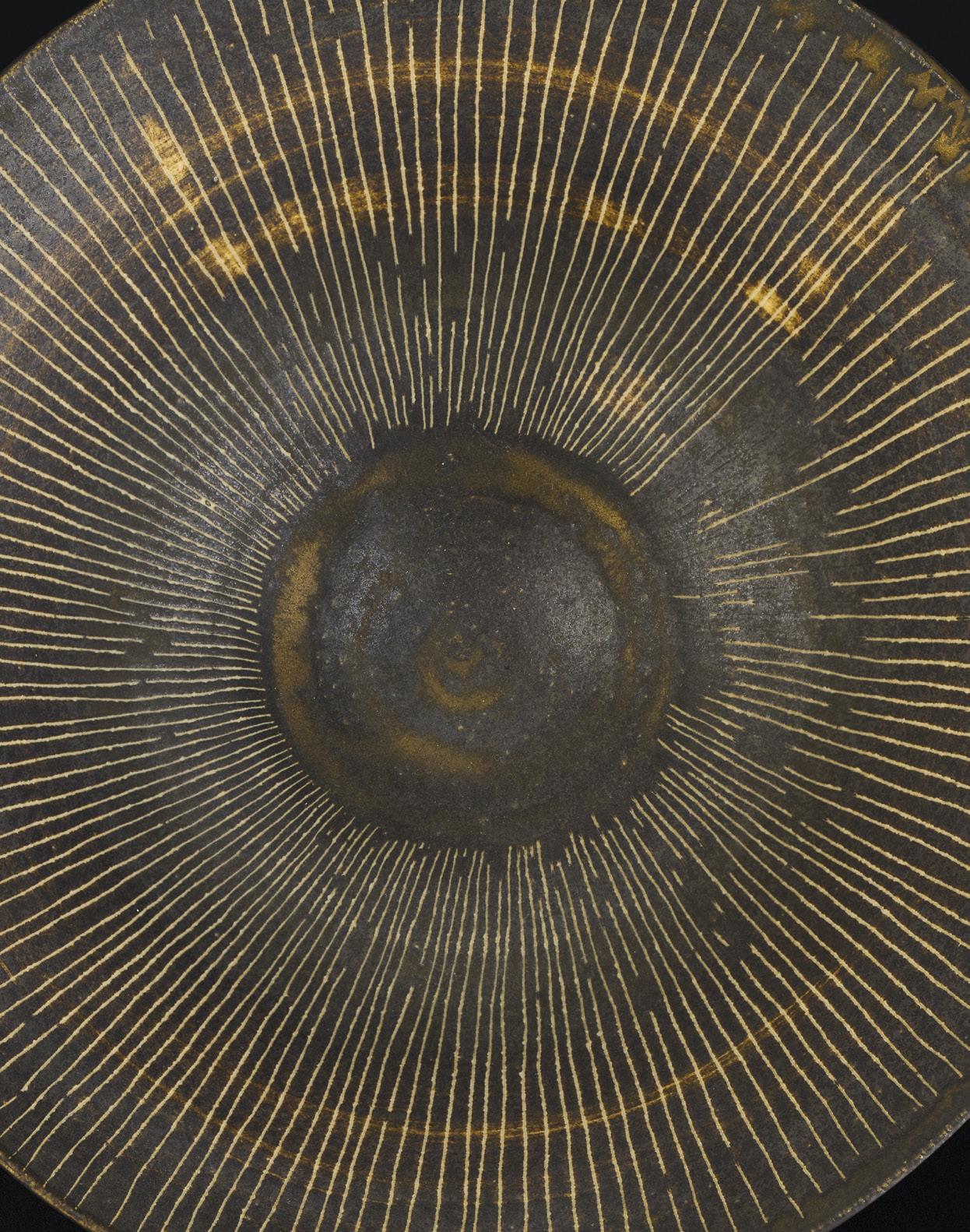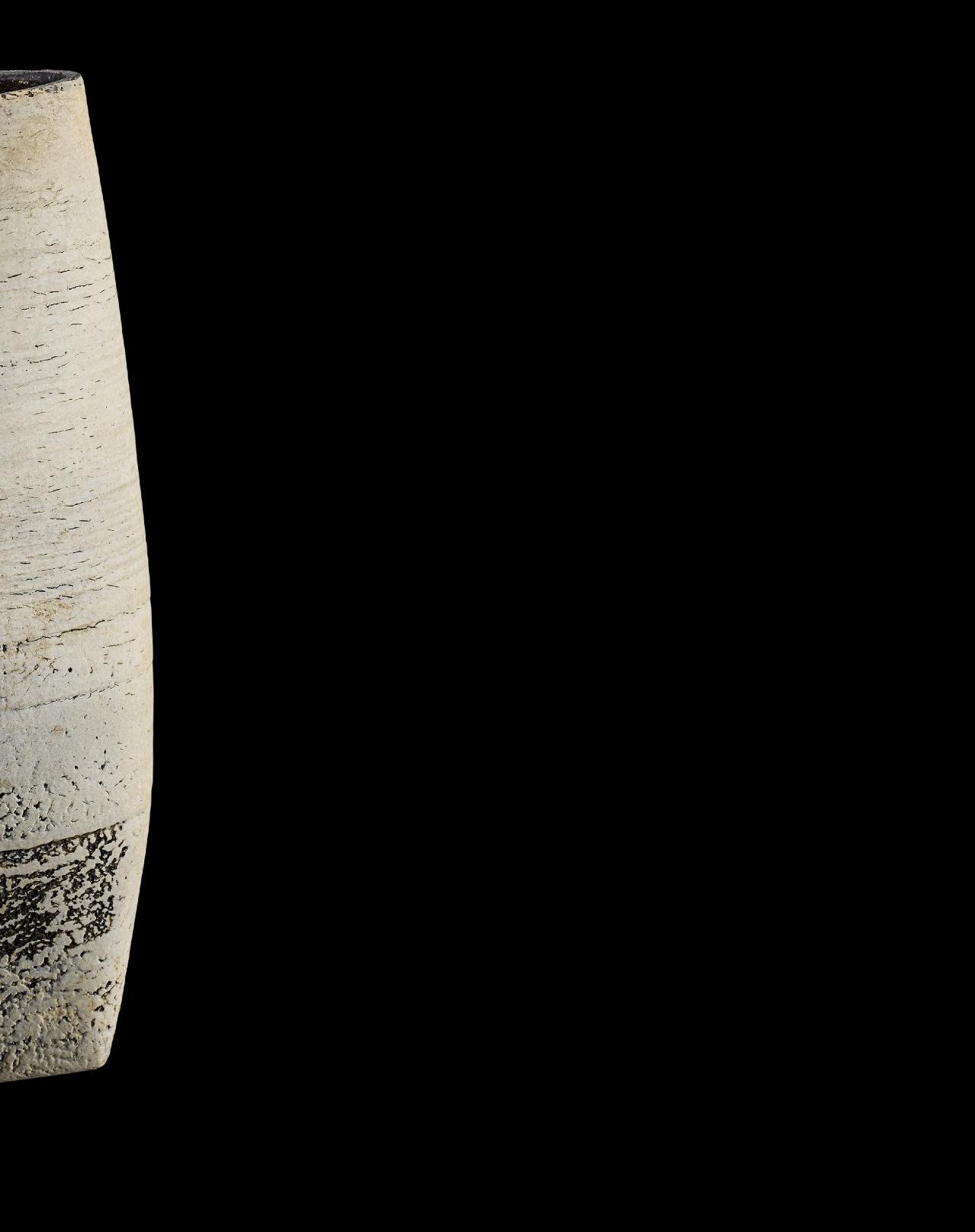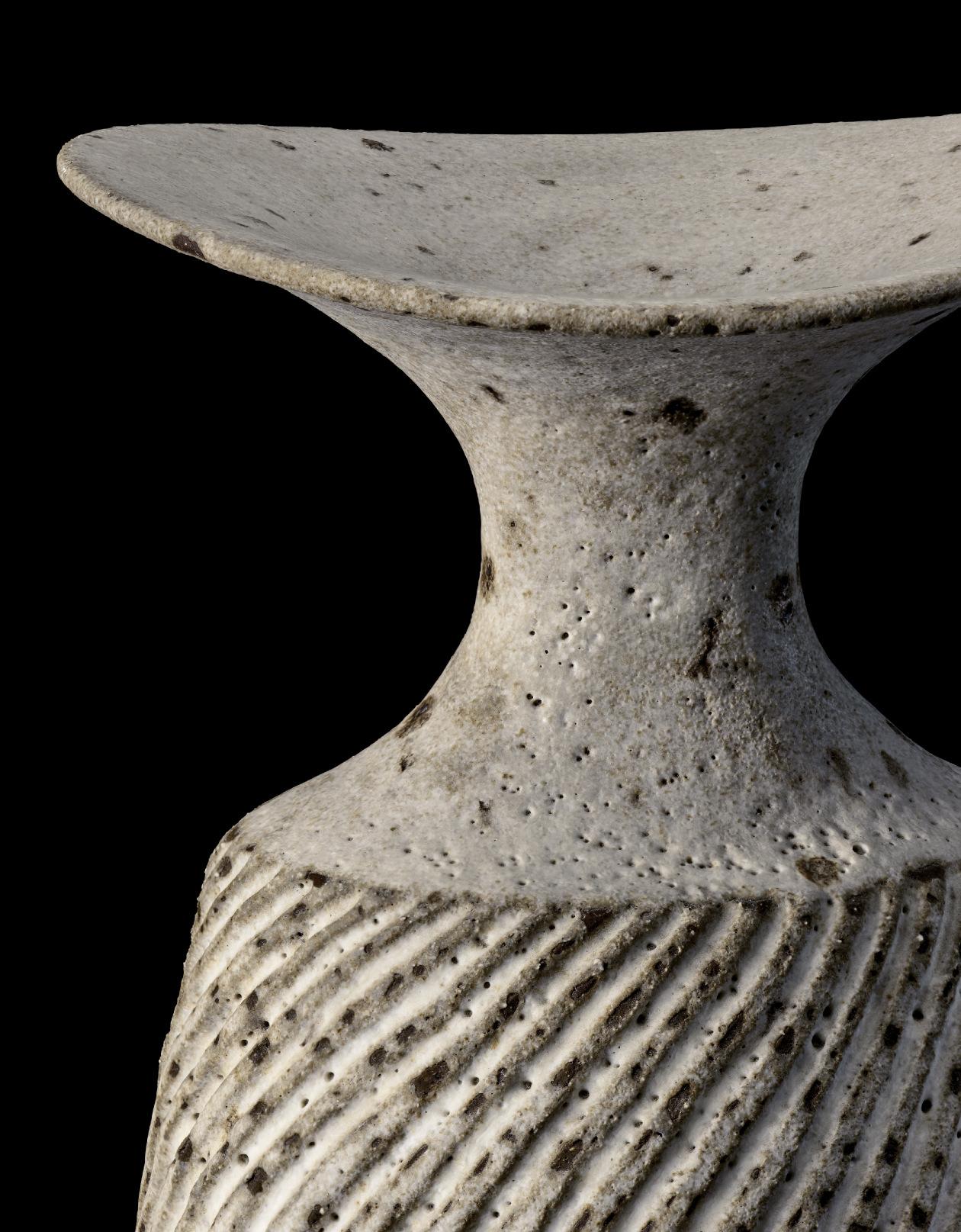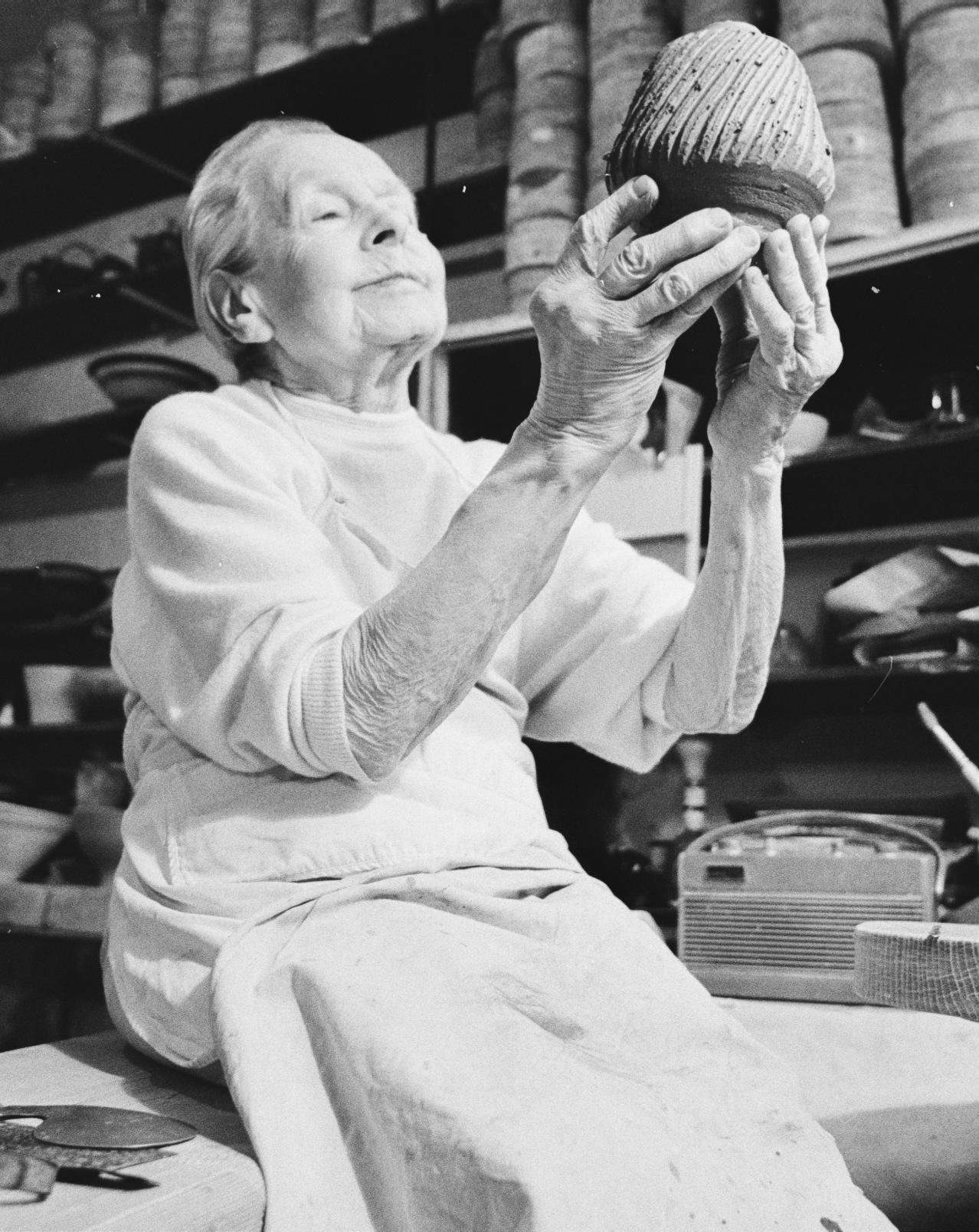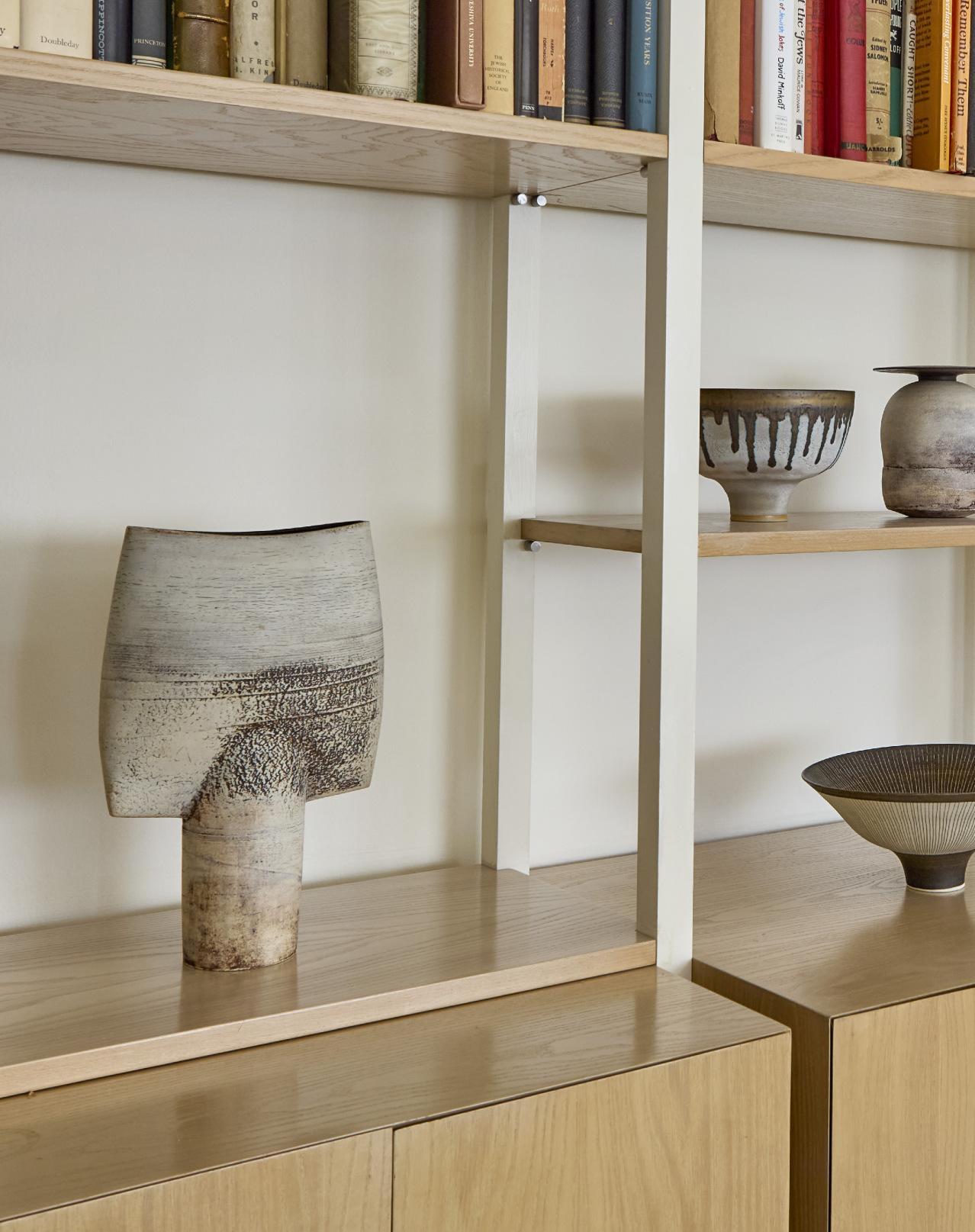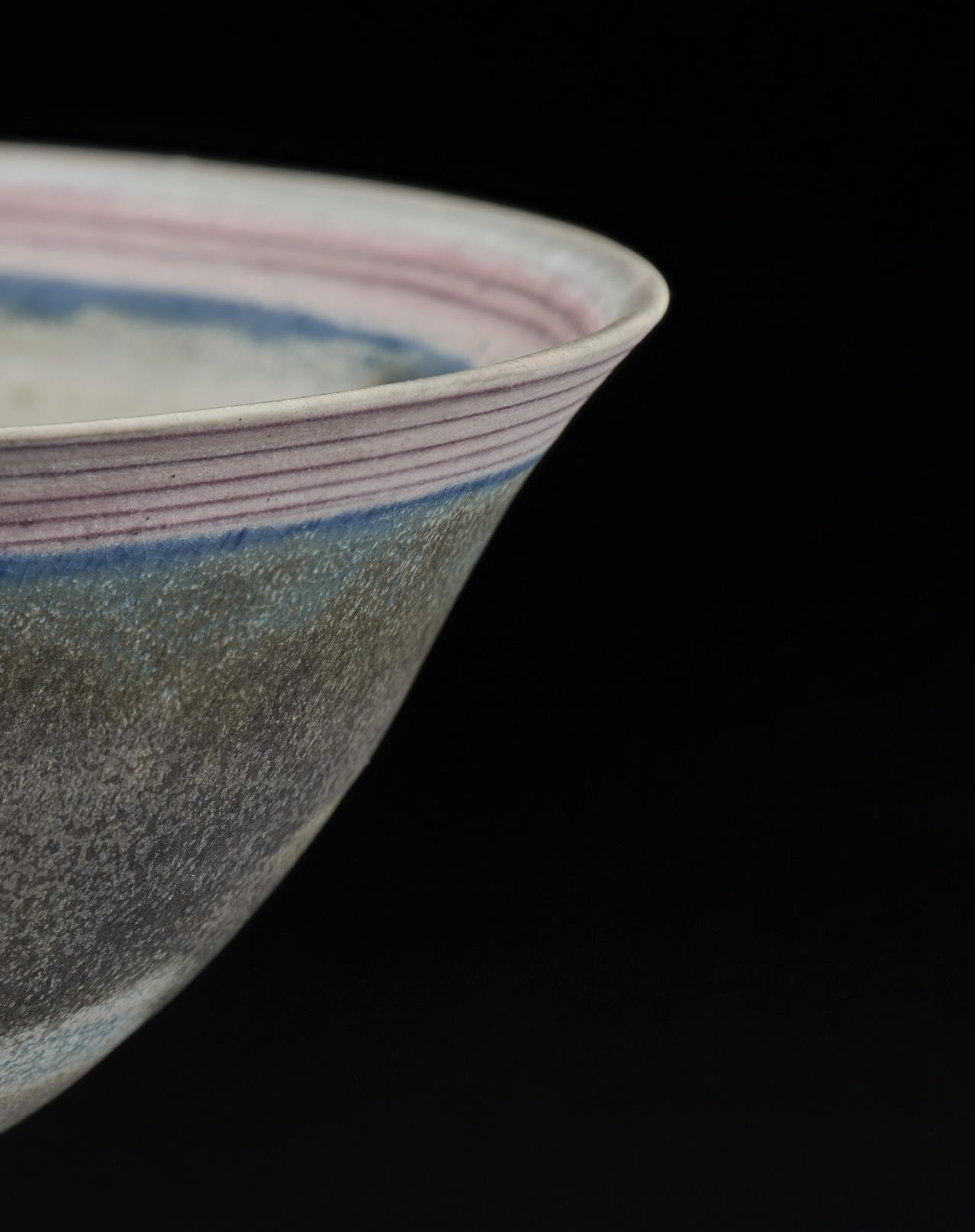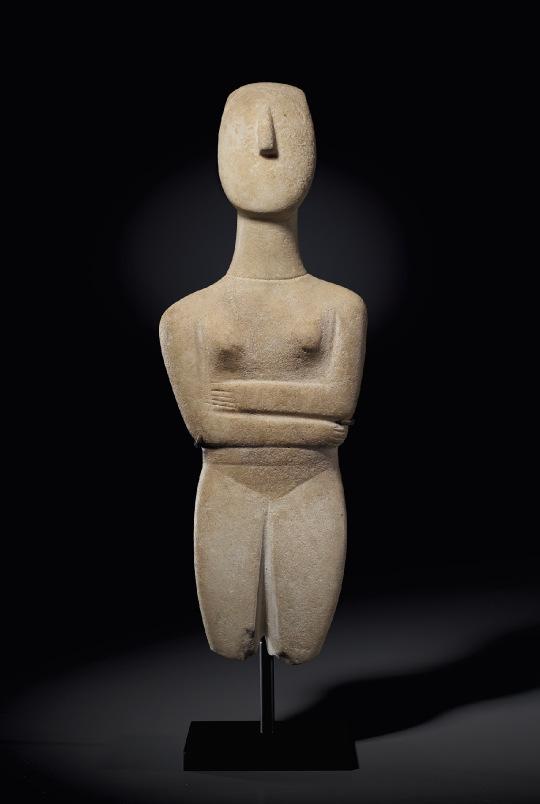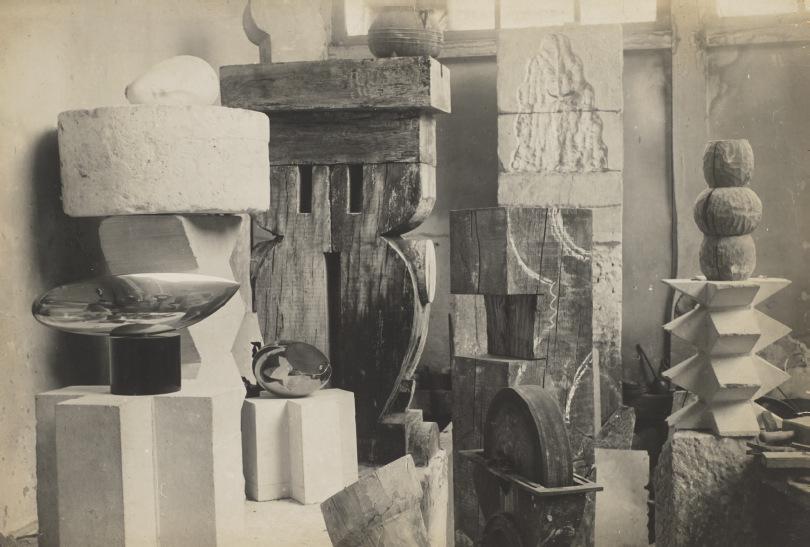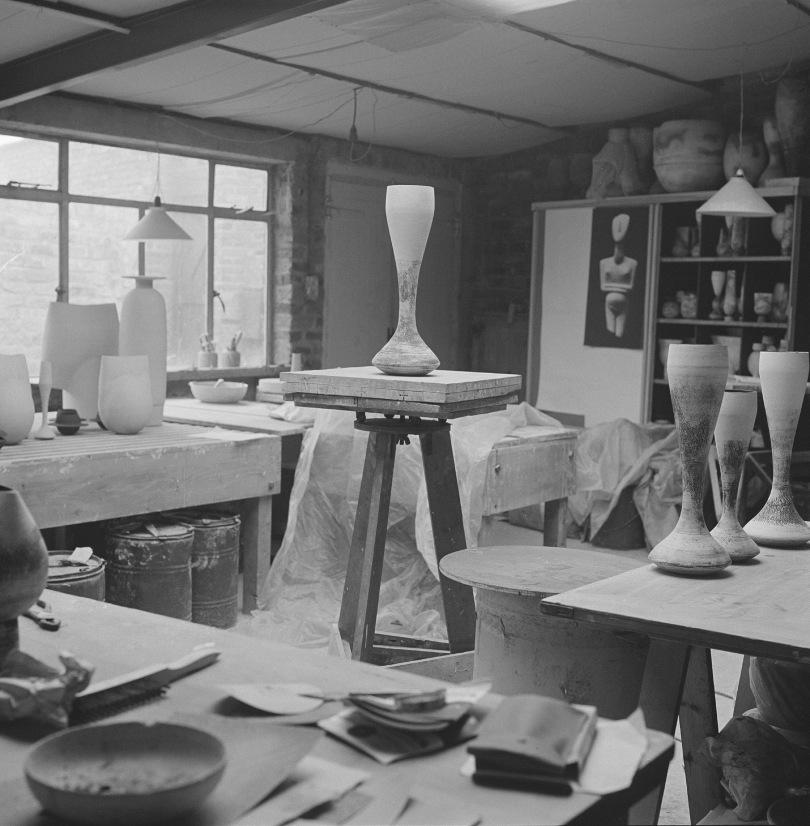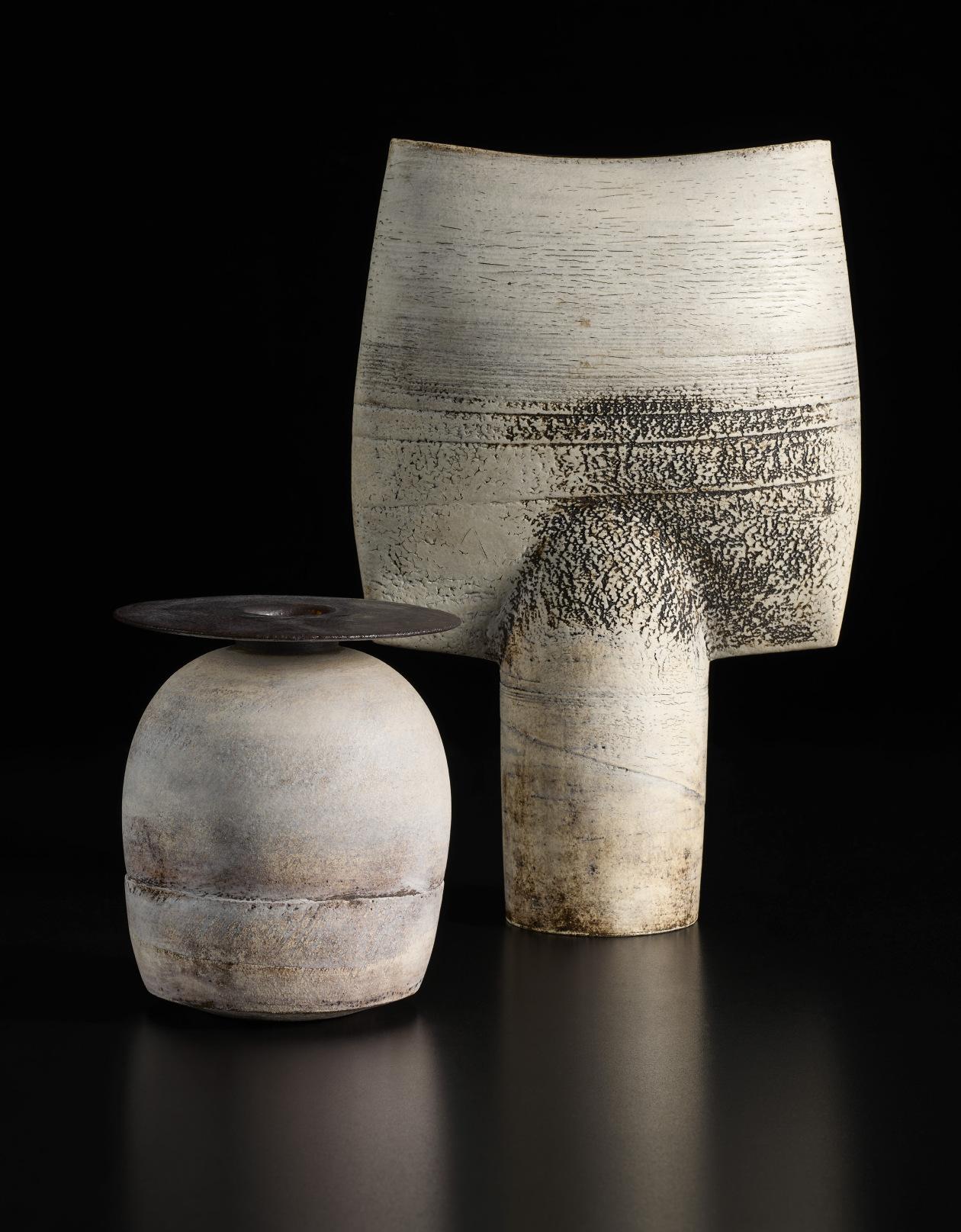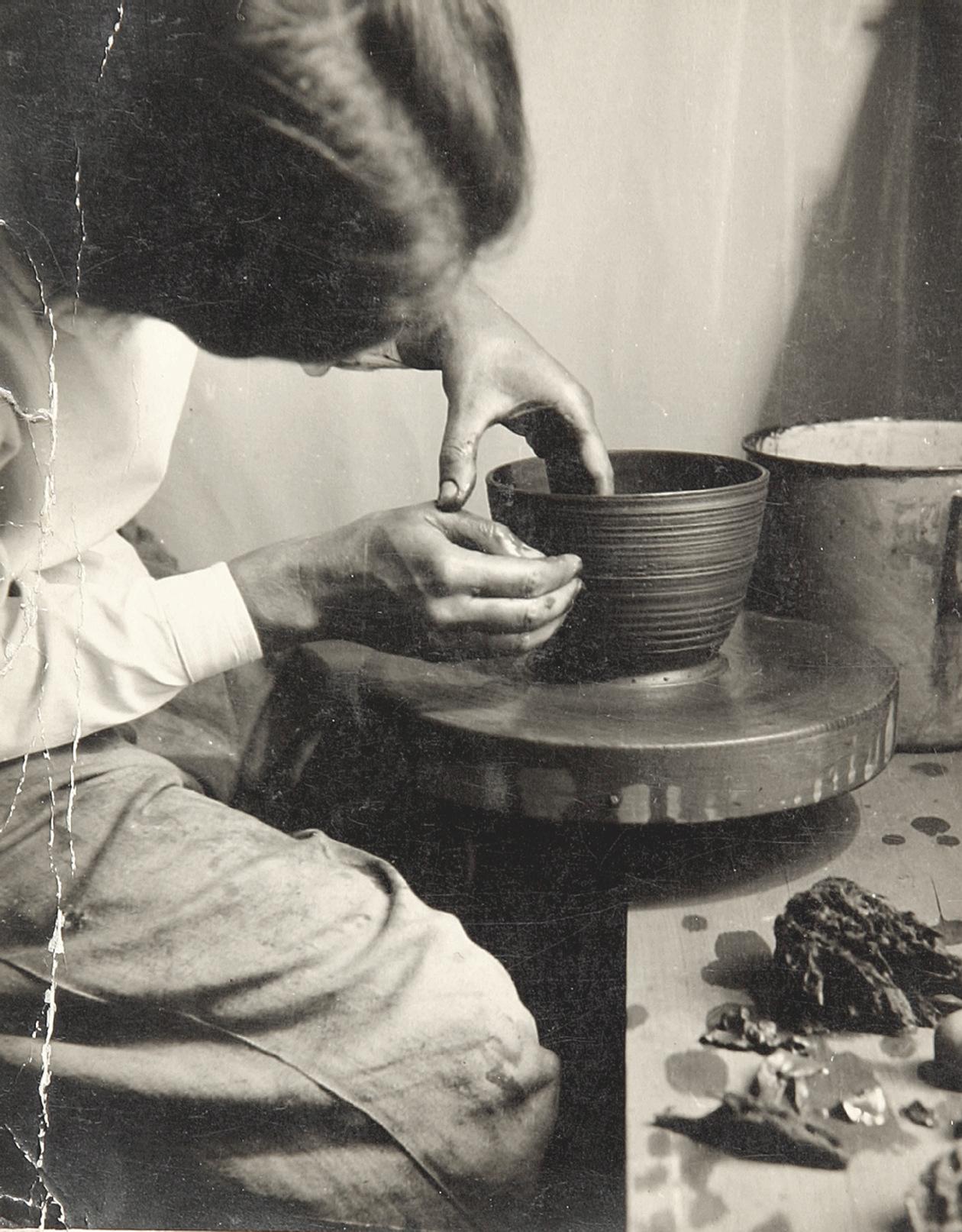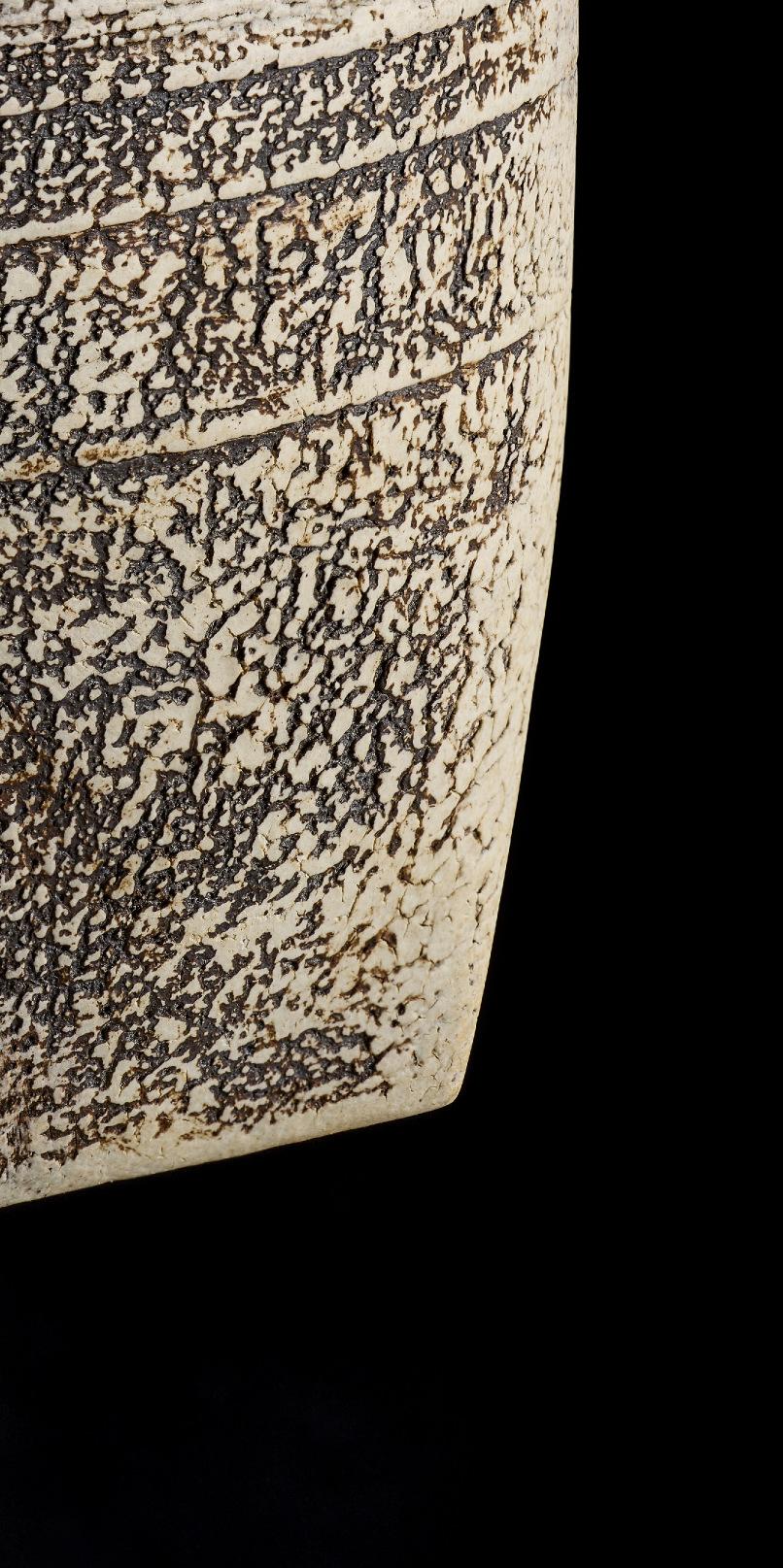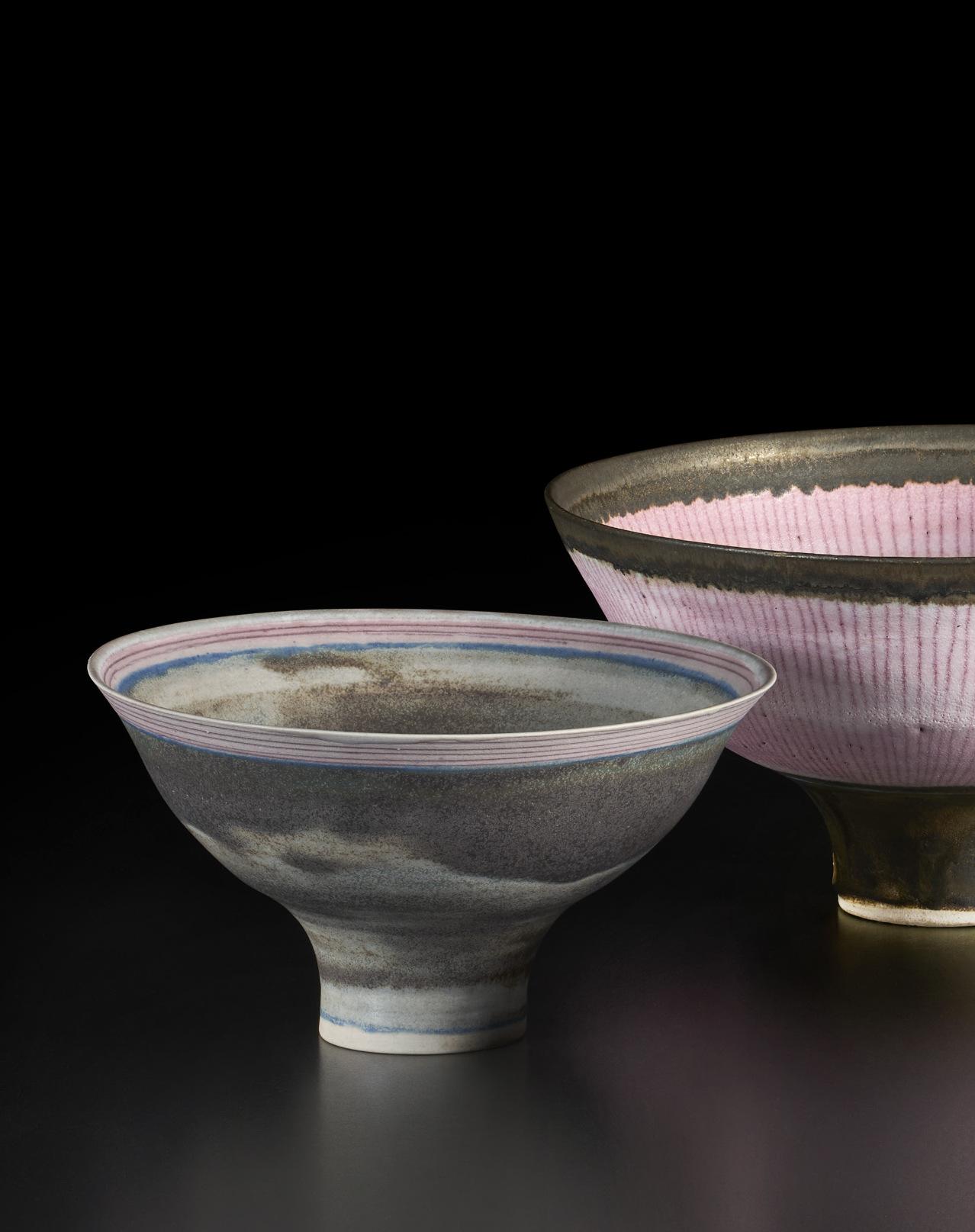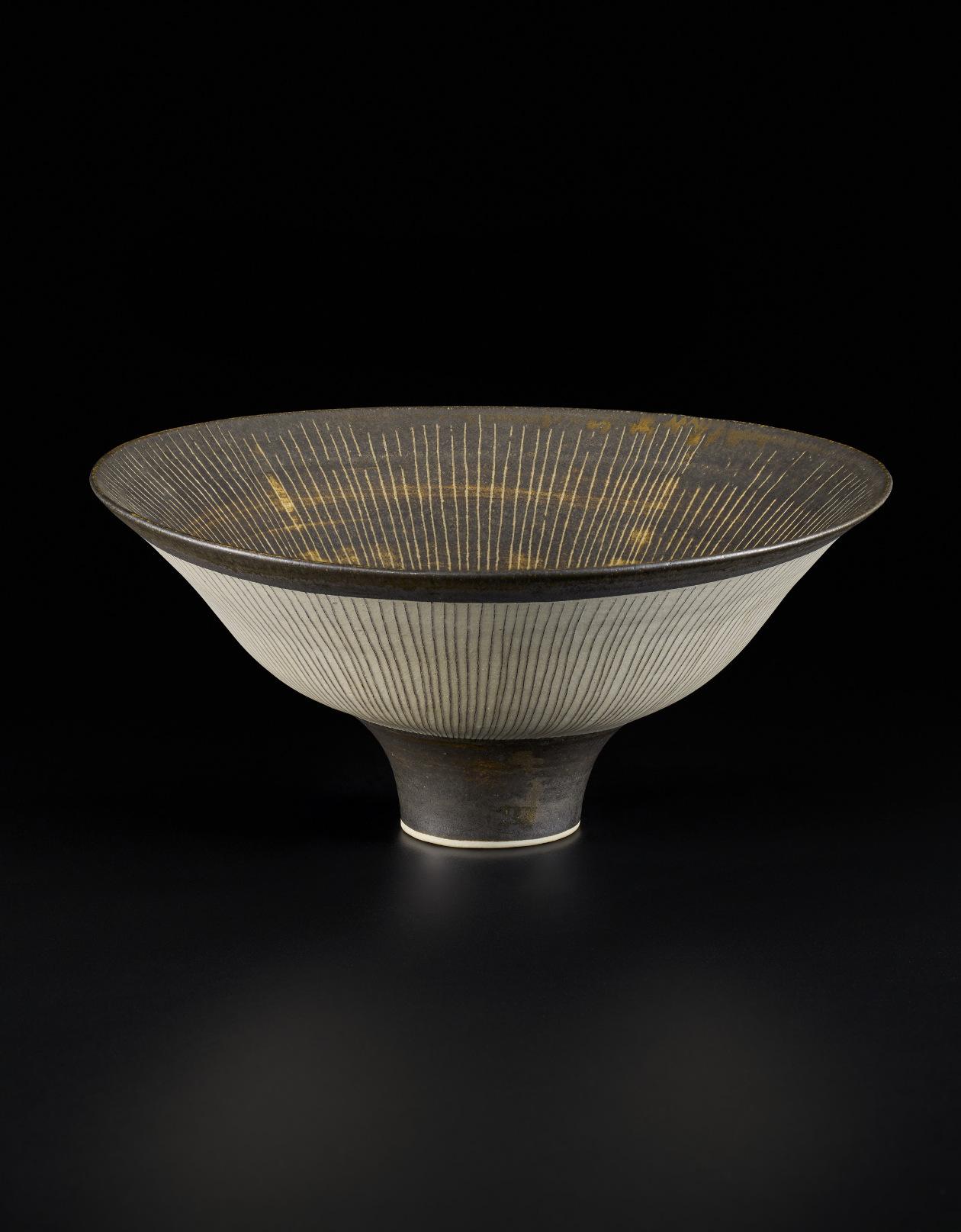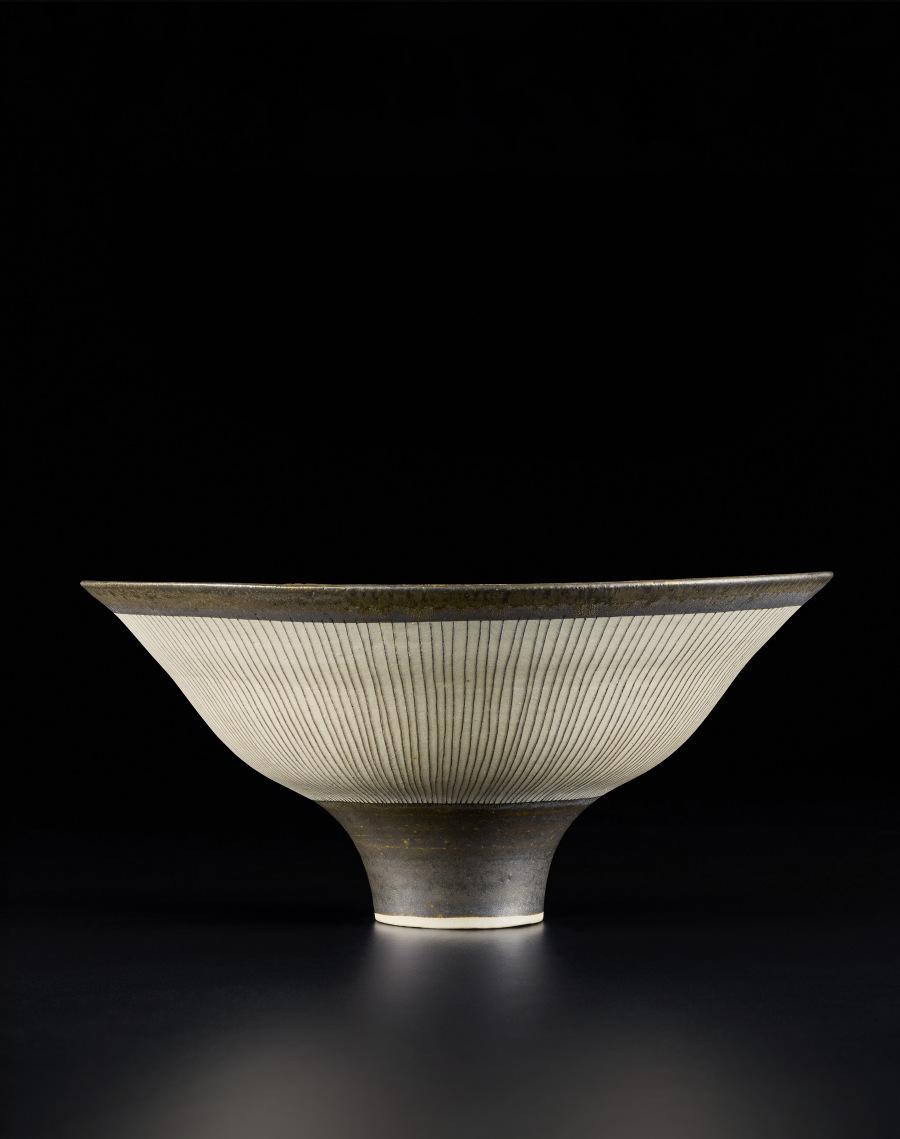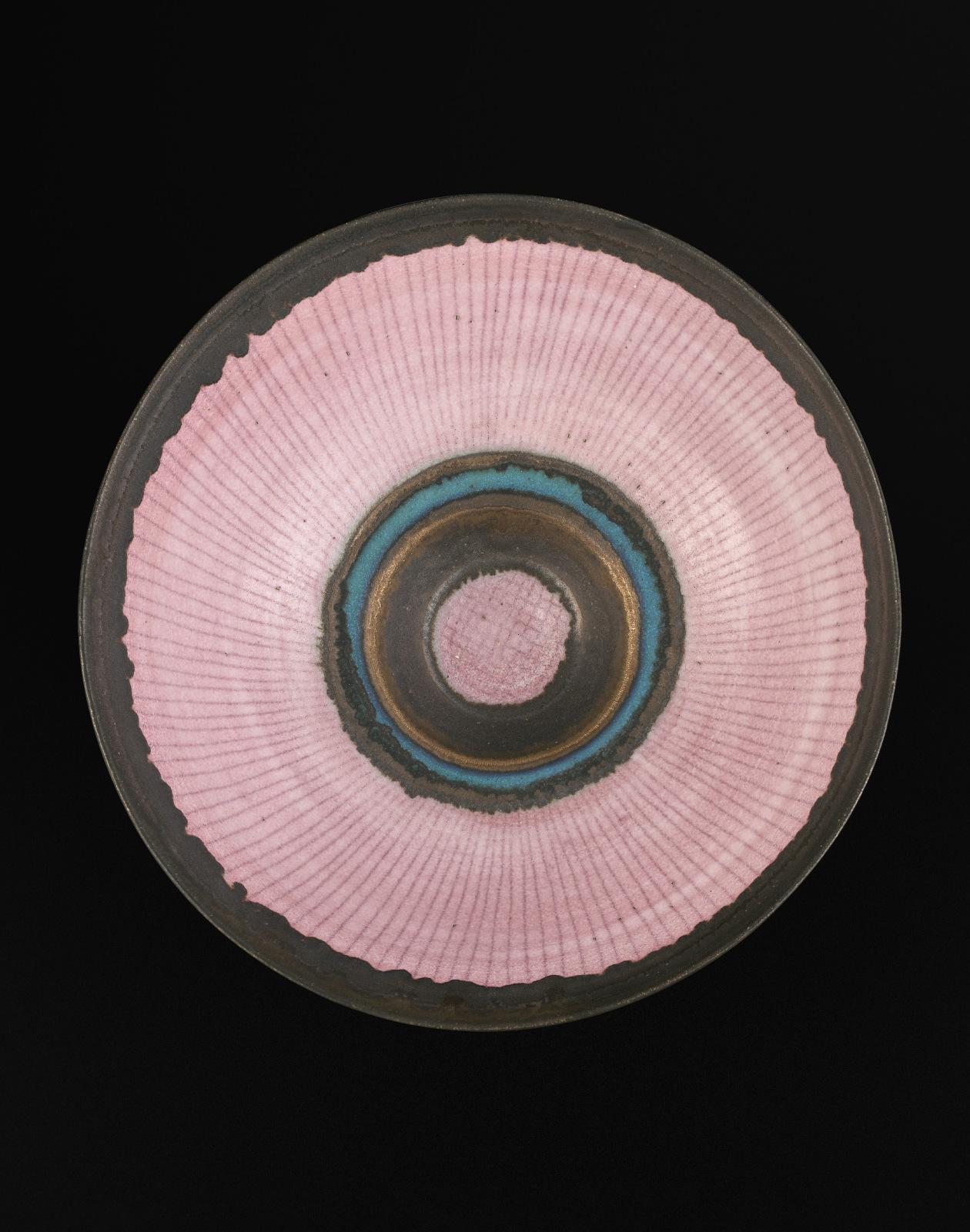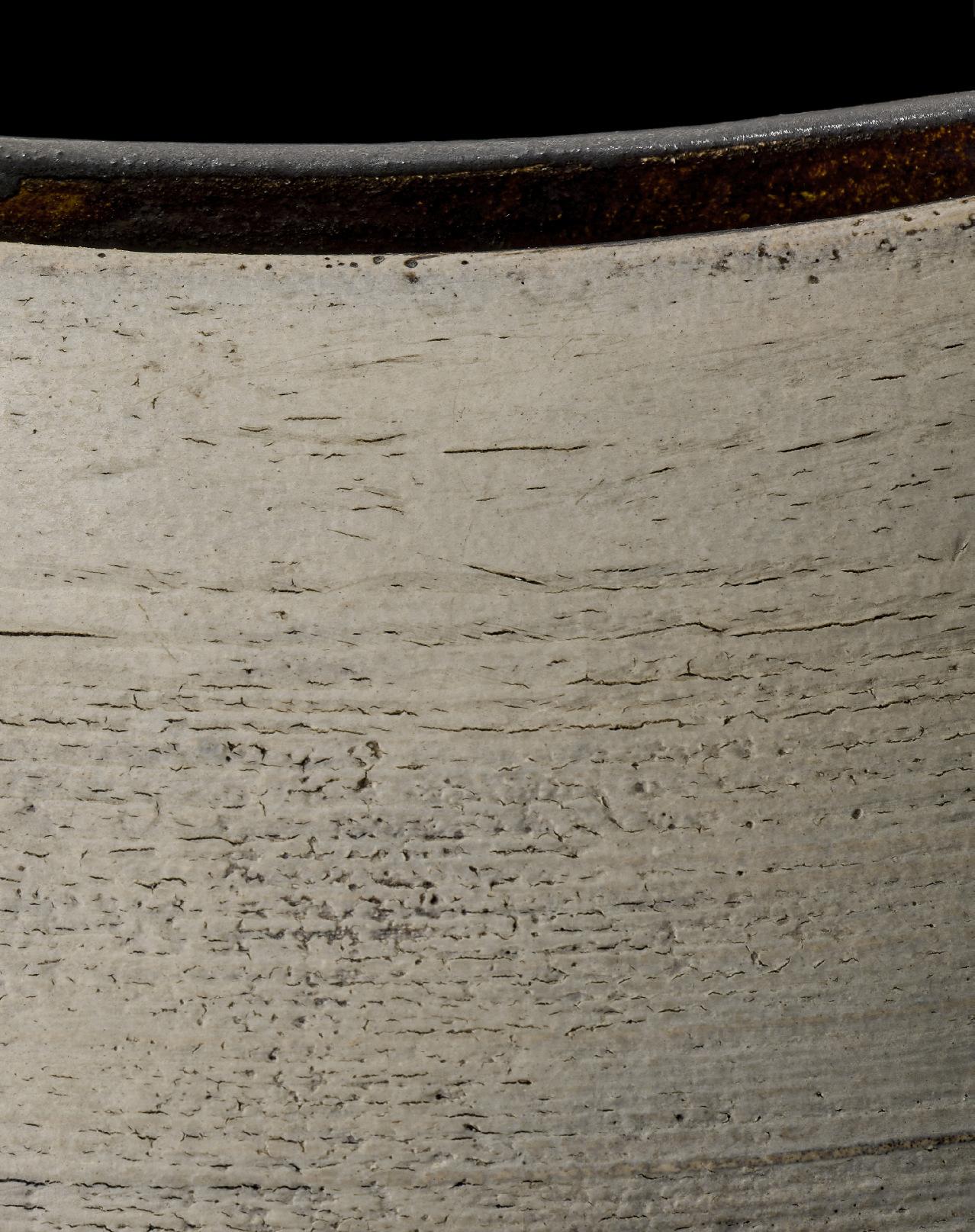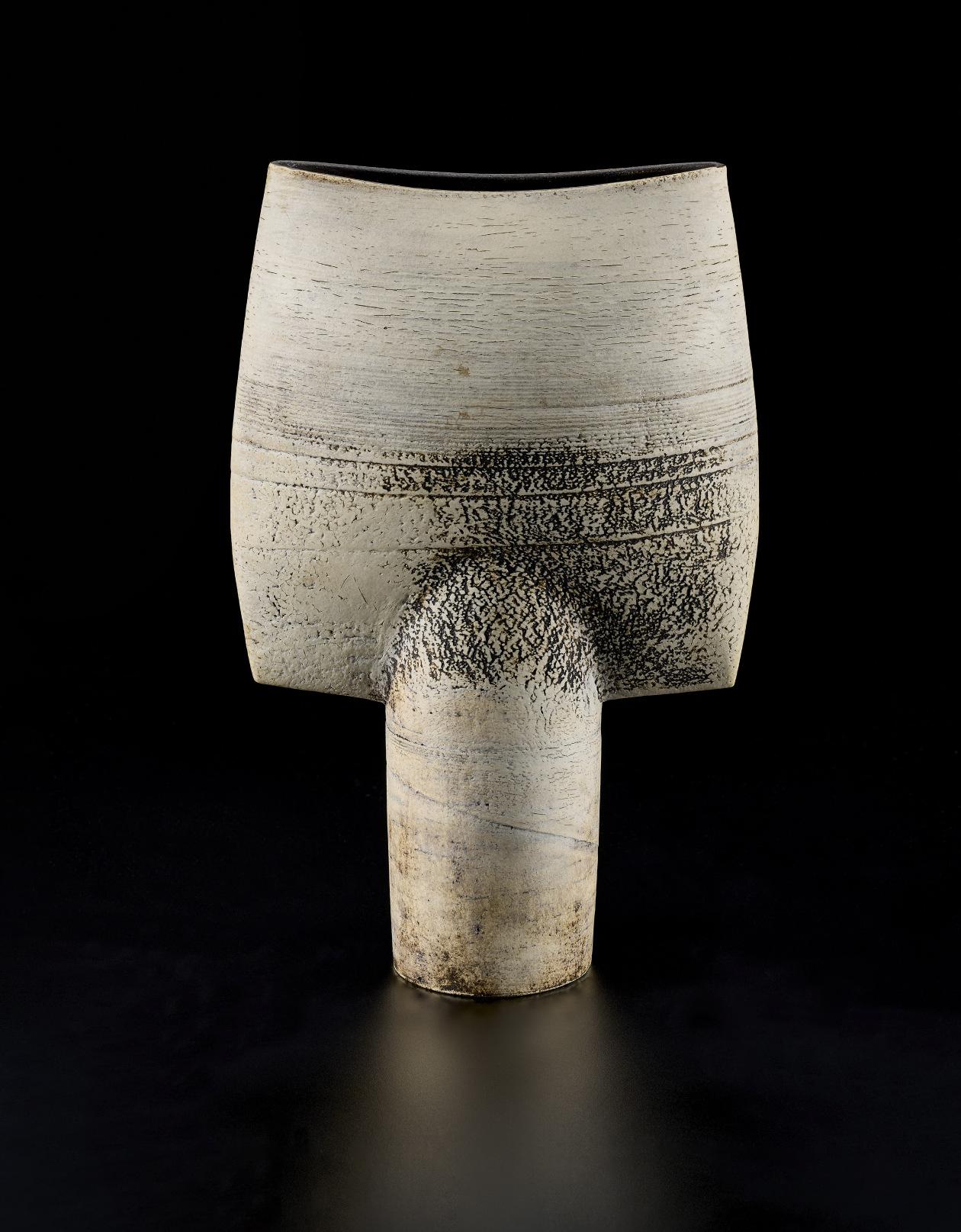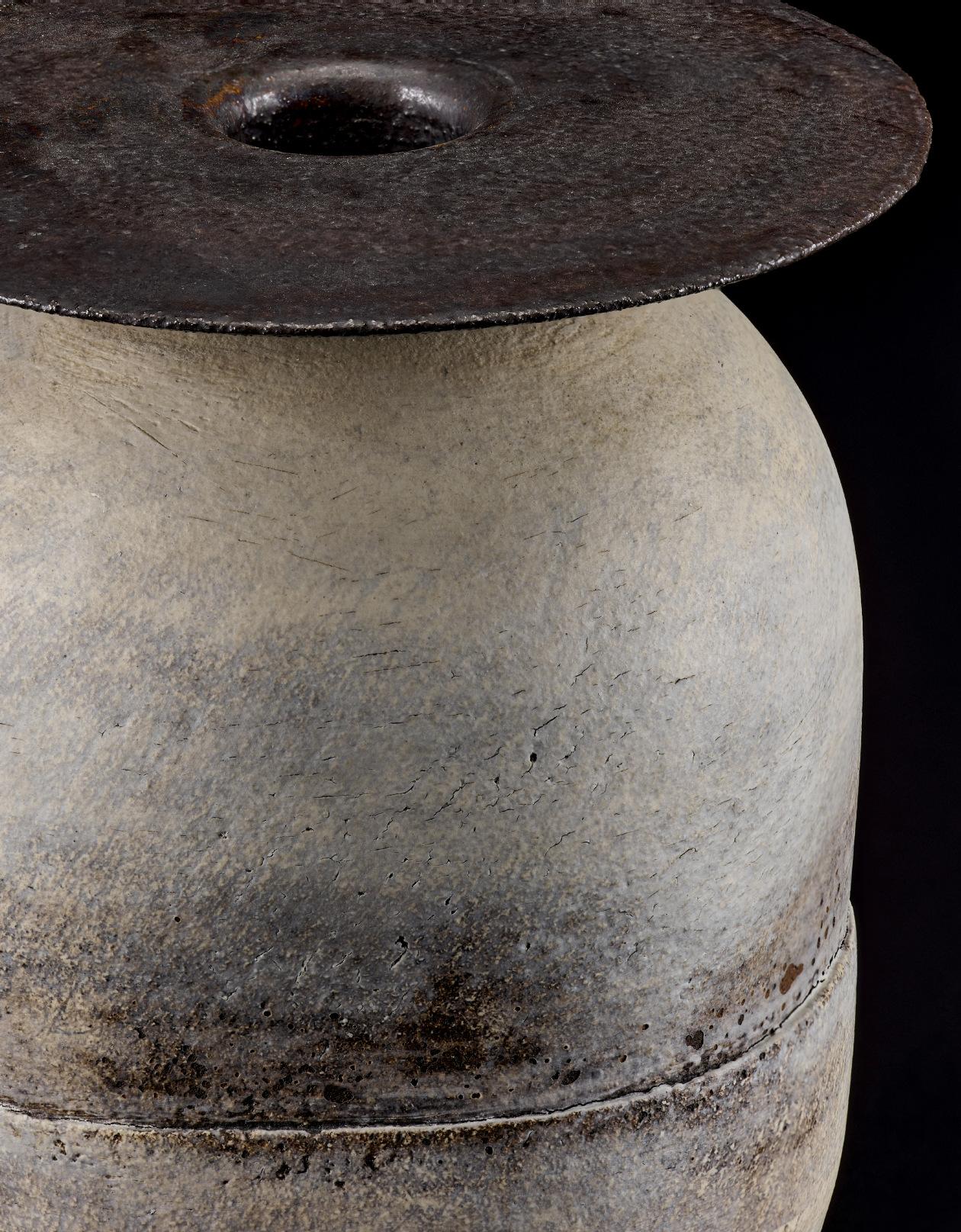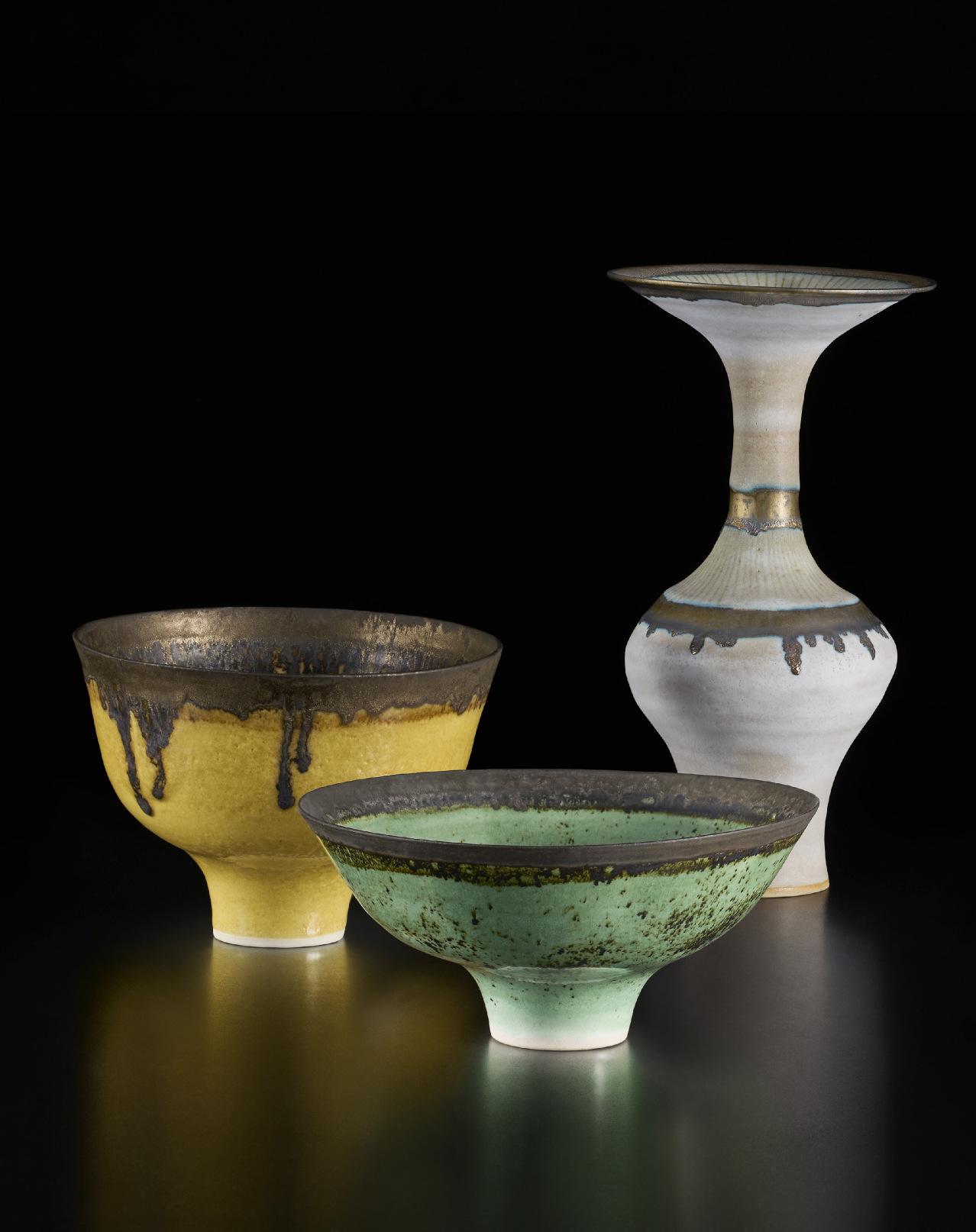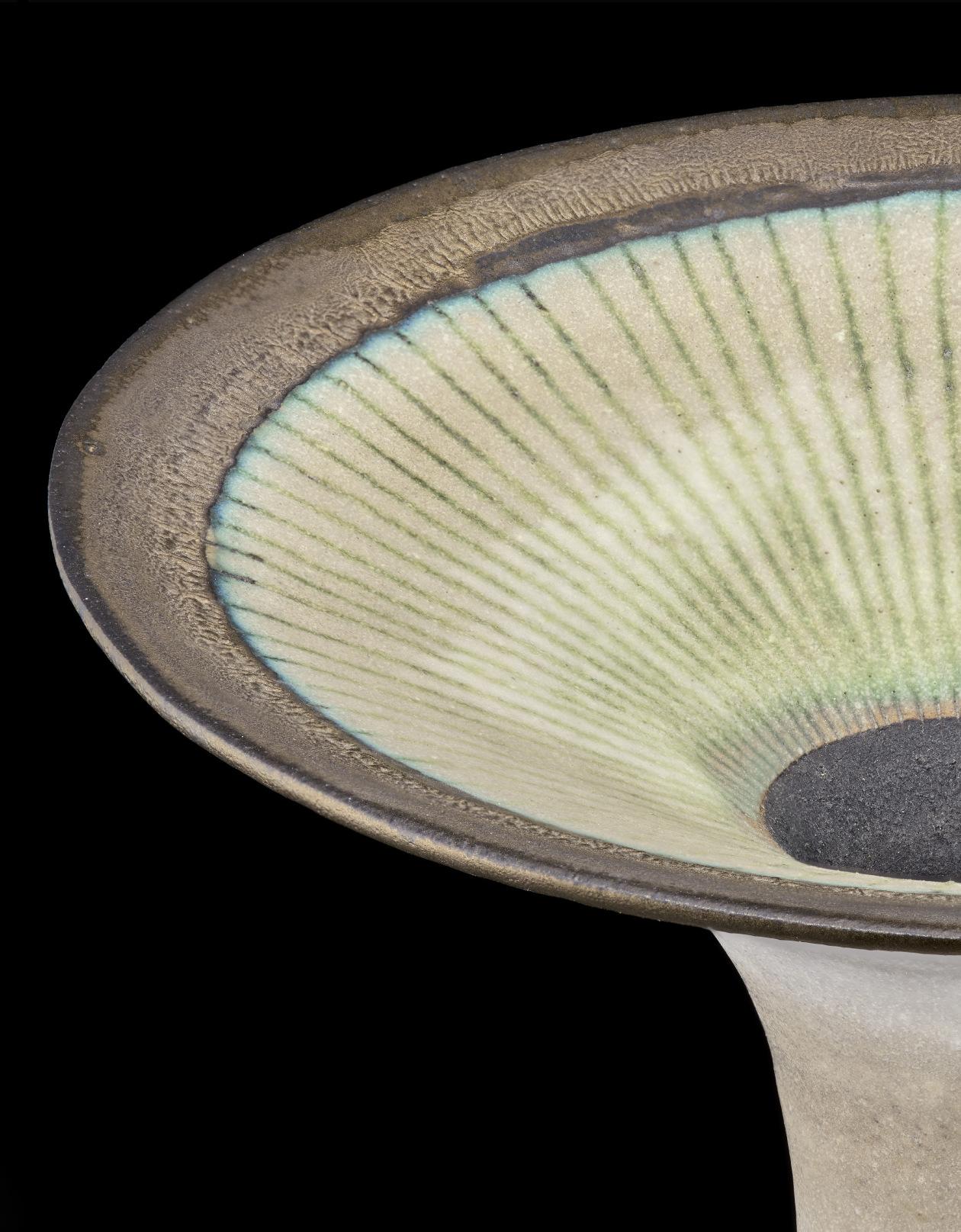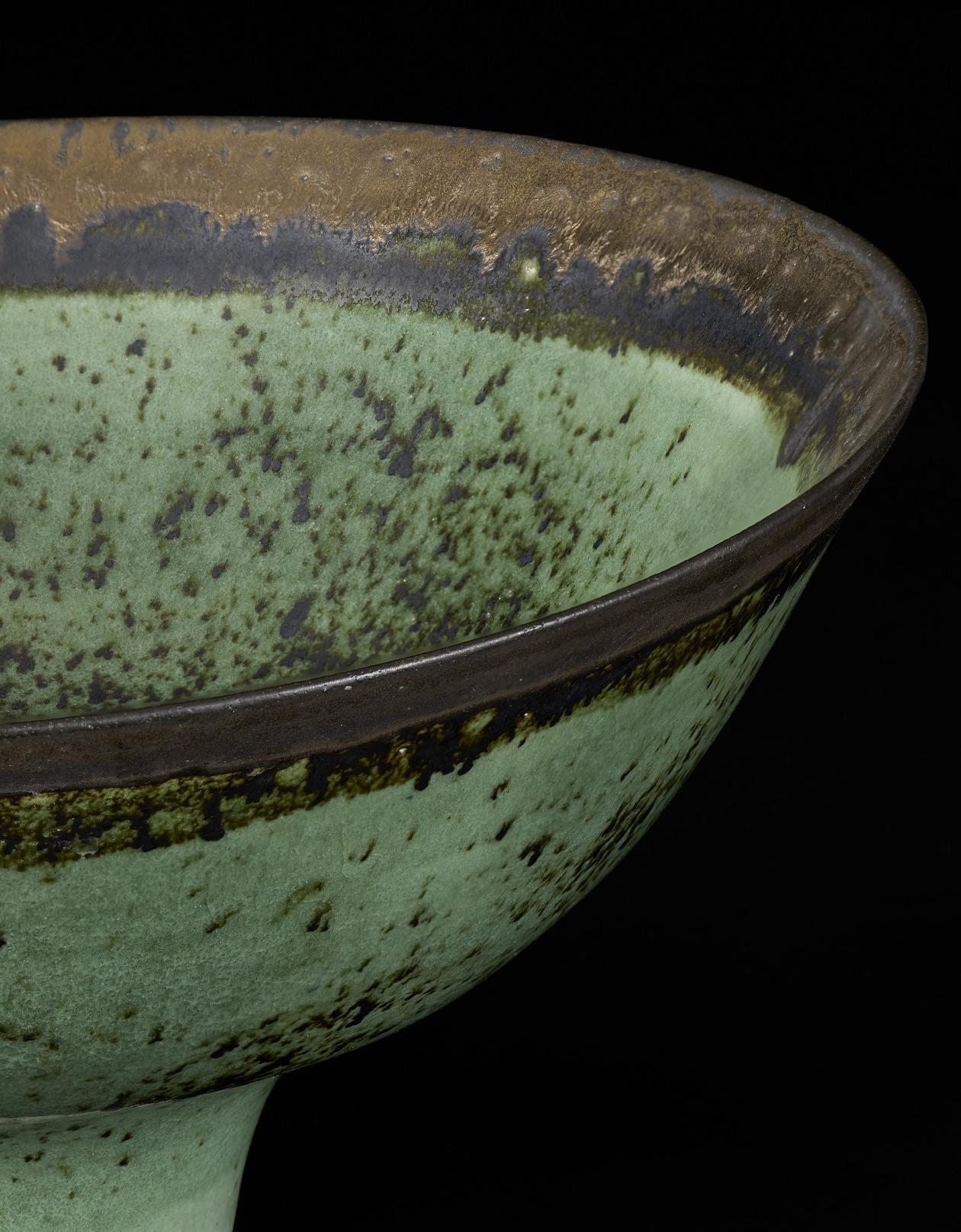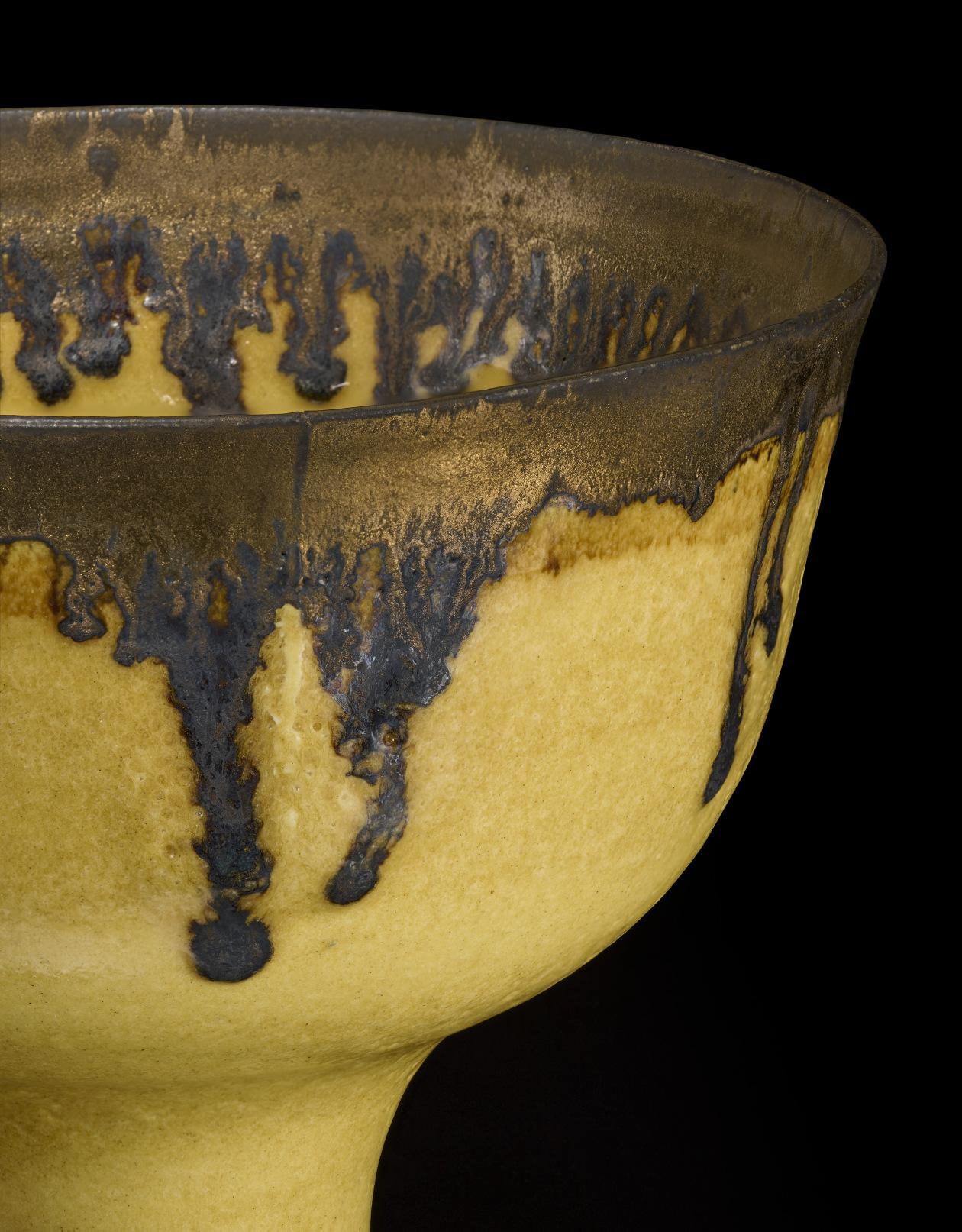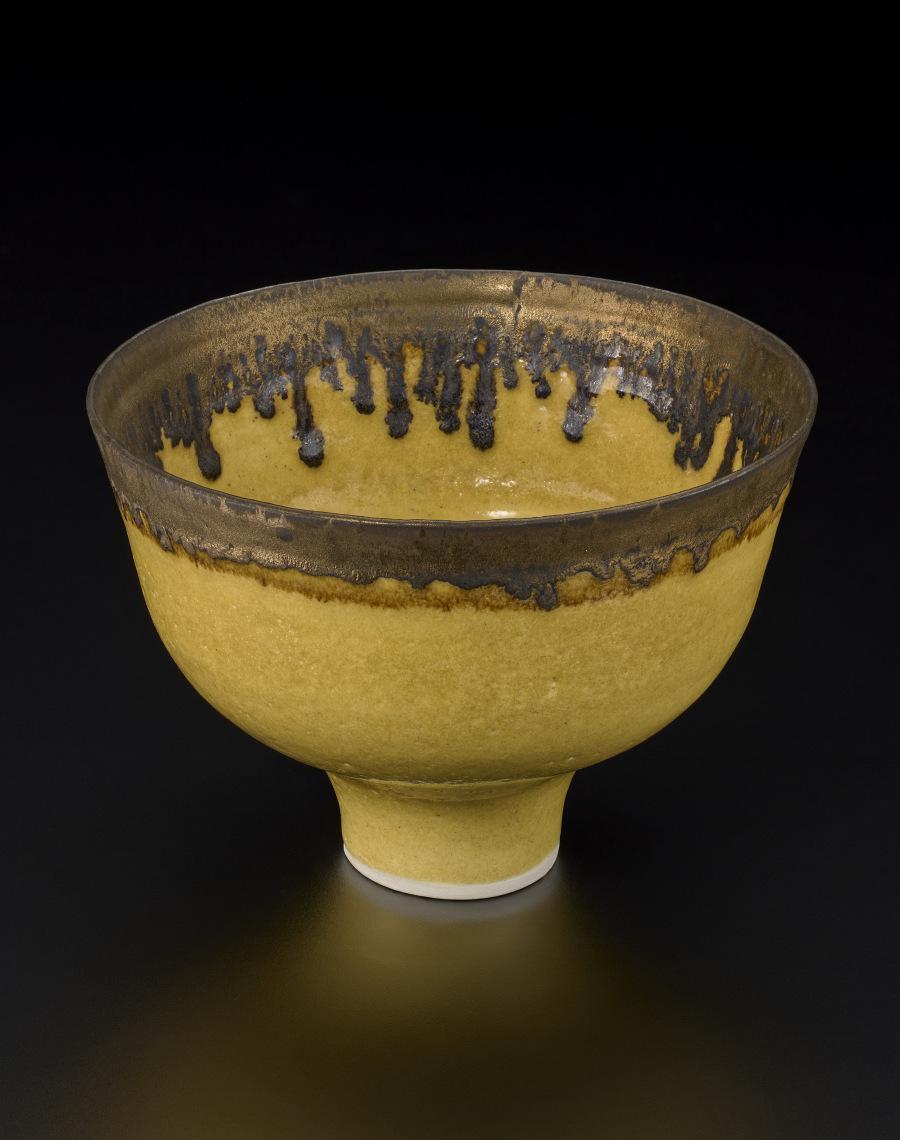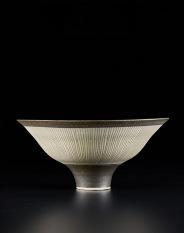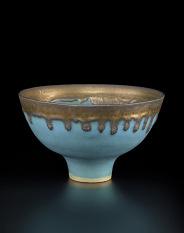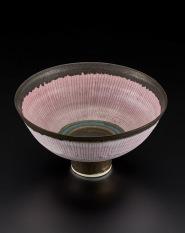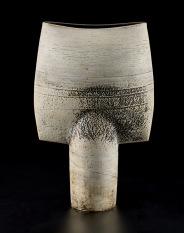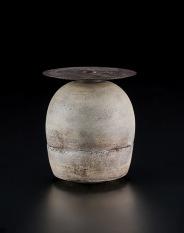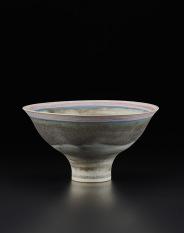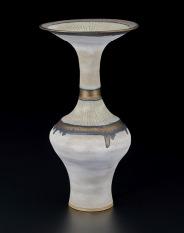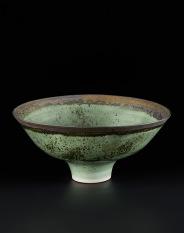The Artistry of Lucie Rie and Hans Coper From Both Sides
ISABELLA SMITH
Through their radically inventive approaches to ceramics, Lucie Rie (1902–1995) and Hans Coper (1920–1981) reshaped what modern studio pottery could be. Speaking towards the end of her six-decade career, Rie said of Coper, her friend and former colleague: ‘I am a potter, but he was an artist.’ This distinction between potter and artist is not one that is universally agreed upon. Though Rie insisted that the humbler term ‘potter’ described her practice best, others disagreed.
In their hands, clay – in Coper’s sculptural vessels and Rie’s tableware and vases – was more than simply a functional medium. While their pieces can be used in a practical sense, they exist equally as aesthetic objects. They have the quality that ceramic artist and writer Alison Britton dubbed ‘double presence’ (The Maker’s Eye, 1982): they are both ‘prose objects’ and ‘poetic objects,’ which is to say, simultaneously functional and sculptural. Britton wrote: ‘To me the most moving things are the ones where I experience in looking at them a frisson from both aspects at once.’ It is this frisson that we find in Coper and Rie’s best work.
Lucie Rie, Hans Coper, London circa 1958 © Jane Coper and the estates of the artists, Courtesy of The Lucie Rie and Hans Coper Foundation.
Consider a typical slim-footed bowl by Rie. These now-classic designs appear almost to float on their narrow base; hardly a practical design choice were one to use the bowl, but one that elevates it, quite literally, from familiarity (a functional bowl) to something other (bowl-as-sculpture). The ‘double presence’ is less immediately apparent in Coper’s overtly sculptural vessels; while Rie was influenced by the form of ancient Roman bowls, Coper drew inspiration from Greek Cycladic figurines and the sculpture of Constantin Brancusi. Nevertheless, you will find it in the photographs of Coper’s vessels filled with grasses, leaves and flowers on display in Rie’s apartment, or in the set of six twometer-high candlesticks he made for Coventry Cathedral in 1962.
A Cycladic Marble Reclining Female Figure, Late Spedos Variety, Early Cycladic II, circa 2500-2400 B.C. Sold at Christie’s, New York, 13 October 2020, lot 18.
Constantin Brâncusi (1876–1957), Vue de l’atelier, circa 1924–1925, gelatin silver print, artist’s sketch in pencil (verso). Sold at Christie’s, New York, 6 October 2021, lot 44.
Hans Coper pots at the Hammersmith Studio circa 1965 © Jane Coper and the estates of the artists, Courtesy of The Lucie Rie and Hans Coper Foundation.
Such presence is unlikely to be achieved without remarkable technical skill. That Rie threw while dressed in white or grey – leaving the wheel with clothes still unblemished – speaks to her elegance, fastidiousness and, of course, her superlative technique. While studying in Vienna in the 1920s, she had been taught to throw using only a minimal amount of water, with no tray to catch splashes. After her escape from Nazi-occupied Austria to London in 1938, she was surprised by the messiness of British-trained potters – and dismayed by disinterest in her continental modernist style, in a nation of potters still dominated by the ‘Anglo-Oriental’ aesthetic of Bernard Leach.
Lucie Rie, ceramic buttons, 1945-1947, L64, Sainsbury Centre, UEA. Photo: © James Austin. © Estate of Lucie Rie.
When Rie met Coper, he was a Jewish refugee like her; unlike her, he had never touched clay, but did draw and paint. In 1946, Rie gave him work in her ‘Button Factory’: a workshop where she employed refugees to make ceramic buttons, buckles and other small accessories. Sensing Coper’s potential, she sent him on a week-long throwing course. Remarkably, he returned proficient. Despite the 18-year age gap, the pair became close friends, and Coper helped Rie regain confidence in her European modernist style. After the war, they entered a pottery partnership, making elegant tableware in a monochrome palette of off-white, matt chocolate brown and glossy black.
Hans Coper at Albion Mews circa 1960 © Jane Coper and the estates of the artists, Courtesy of The Lucie Rie and Hans Coper Foundation.
“DON’T, please DON’T, either of you, heed what ‘they’ say — about wanting novelty and change. Your steadfastness and integrity as potters, your following your own path, is what keeps your work so fine and good and unsullied.”
ROBIN TANNER, 1950S, IN A LETTER TO LUCIE RIE AND HANS COPER
In some ways, those buttons predicted Rie’s vividly hued later work. Couturiers would show Rie a swatch of cloth and in a couple of days, she would have developed a button with texture and colour to match – a feat of glaze chemistry. In the colour palette, glaze materials and range of these humble objects, there are echoes of her celebrated bowls of the 1970s and ’80s. Unlike most potters, she always raw-glazed her work: applying glaze to unfired (rather than once-fired) clay, a technique that in less skilful hands would lead to pots collapsing.
For Coper’s part, the monochrome palette of the tableware made together during those post-war years developed into a more austere aesthetic all his own. In 1958, he left their cramped London workshop for a studio in the Hertfordshire countryside, where his work could grow in scale and ambition. As Rie’s pots became increasingly jewel-like – emerald green, turquoise, pink and yellow glazes, metal-toned rims and lines of sgraffito or inlay – his became more matt and textural, in off-whites, buff, brown and black.
Coper experimented with burnishing or scouring his surfaces, abrading either the clay itself, layered dark oxides or white slips – and focused, above all, on form. He developed a series of distinct forms he termed Spade, Bud, Cup, Egg, Flower and Arrow. These were thrown at the wheel, either in their entirety or in separate sections to be assembled by hand. The results have often been described as totemic, with a timeless quality that bridges the ancient and the modern.
Hans Coper, two vessels, from the Collection of Robert F. and Patricia G. Ross Weis.
Today, the work of Rie and Coper stands as the pinnacle of British studio ceramics of the 20th century, carrying with them a legacy of friendship, innovation and uncompromising artistry.
ISABELLA SMITH, writer and editor. Her first book, Lucie Rie, was published by Eiderdown Books in 2022. Her writing has appeared in Frieze, The Guardian, The Financial Times, The Telegraph, and World of Interiors. She previously served as senior editor at Apollo magazine. She holds a master’s degree from the Courtauld Institute of Art, where she specialized in the use of raw clay in 1970s performance art.
Photograph of vessels by Hans Coper filled with flowers in the Albion Mews pottery, 1950. © Estate of Lucie Rie. From the collections of the Crafts Study University for the Creative Arts, UK, RIE/20/5/11/9/2.
Lucie Rie at the wheel in Vienna, circa 1935. From the Crafts Study Centre, University for the Creative Arts, CFC/1/3.
© Estate of Lucie Rie.
“Lucie Rie’s pots reveal an instinct for powerful concision, for the paring back of forms, textures, functions: to the essential. Her life reveals someone who was able to get to the point.”
EDMUND DE WAAL, “MODERN THINGS”, 2023
Please find additional cataloguing information for all lots on pages 58–61
LUCIE RIE (1902-1995) Footed Bowl, circa 1984 stoneware with pitted white glaze and manganese rim 4¾ in. (12 cm) high, 6¾ in. (17.2 cm) diameter impressed with artist’s seal $40,000-60,000
LUCIE RIE (1902-1995) Footed Bowl, circa 1976 porcelain with manganese glaze and radiating sgraffito and inlaid design 4º in. (10.8 cm) high, 9¡ in. (23.8 cm) diameter impressed with artist’s seal $40,000-60,000
impressed
LUCIE RIE (1902-1995) Footed Bowl, circa 1982 stoneware, blue glaze with bronze lip and manganese drip 3¾ in. (9.5 cm) high, 6¼ in. (15.8 cm) diameter
with artist’s seal $40,000-60,000
RIE (1902-1995) Footed Bowl, circa 1984 porcelain with pink radiating inlay and turquoise and manganese bands 5 in. (10.6 cm) high, 9 in. (22.8 cm) diameter
impressed with artist’s seal $60,000-80,000
LUCIE
HANS COPER (1920-1981) Large ‘Spade’ Form, circa 1966 stoneware with layered white porcelain slips and engobes over a textured and incised body with manganese glaze
12½ x 8¼ x 4¾ in. (31.8 x 21 x 14.5 cm) impressed with artist’s seal $70,000-100,000
HANS COPER (1920-1981) Bottle with Disc Top and Indents, circa 1971 stoneware with layered white porcelain slips and engobes over a textured and incised body, the neck and disc with manganese glaze 5¾ (14.6 cm) high, 5 in. (12.7 cm) diameter impressed with artist’s seal $30,000-50,000
LUCIE RIE (1902-1995) Footed Bowl, circa 1980 stoneware with inlaid pink lines and vivid blue band over blue-grey body 4 in. high (10.2 cm) high, 7¼ in. (18.4 cm) diameter impressed with artist’s seal $20,000-30,000
LUCIE RIE (1902-1995) Vase with Flaring Lip, circa 1981 stoneware with white glaze, green radiating sgraffito inlay, and gold lip and running bands 10¾ in. (27.3 cm) high, 5¾ in. (14.6 cm) diameter impressed with artist’s seal $20,000-30,000
impressed with artist’s seal $30,000-50,000
LUCIE RIE (1902-1995) Footed Bowl, circa 1982 porcelain, emerald green glaze with bronze lip and manganese speckle 3¾ in. (9.5 cm) high, 8 in. (20.3 cm) diameter
RIE (1902-1995) Vase with Flaring Lip, circa 1970 stoneware, mixed clays thrown together to produce an integral spiral below the glaze 6¼ x 3¾ x 3¼ in. (15.8 x 9.5 x 8.2 cm) impressed with artist’s seal $6,000-8,000
LUCIE
LUCIE RIE (1902-1995) Vase with Fluted Body and Flaring Lip, circa 1975 stoneware with matte gray glaze, manganese speckle, and deep diagonal fluting 7¼ in. (18.4 cm) high, 5⅜ in. (13.7 cm) diameter impressed with artist’s seal $10,000-15,000
LUCIE RIE (1902-1995) Footed Bowl, circa 1984 porcelain with yellow glaze and manganese running rim 5⅛ in. (13 cm) high, 7 in. (17.8 cm) diameter impressed with artist’s seal $25,000-35,000
PROVENANCE
Private Collection, London
LUCIE RIE (1902-1995)
Footed Bowl, circa 1984
stoneware with pitted white glaze and manganese rim
4æ in. (12 cm) high, 6æ in. (17.2 cm)
diameter
impressed with artist’s seal
$40,000-60,000
International Contemporary Ceramics, Bonham’s, London, 20 September 2005, lot 114
Acquired from the above by the present owner
LITERATURE
Lucie Rie: a survey of her life and work, exh. cat., Crafts Council and The Victoria and Albert Museum, London, 1981, p. 89, no. 215 (for a related example)
C. Frankel, Modern Pots. Hans Coper, Lucie Rie & their Contemporaries: The Lisa Sainsbury Collection, London, 2000, p. 127 (for a related example)
Lucie Rie - a retrospective, exh. cat., The National Museum of Modern Art, Tokyo, 2010, pp. 236, 328, no. 179 (for a related example)
PROVENANCE
Fischer Fine Art Ltd., London
LUCIE RIE (1902-1995)
Footed Bowl, circa 1976
porcelain with manganese glaze and radiating sgraffito and inlaid design
4º in. (10.8 cm) high, 9⅜ in. (23.8 cm) diameter
impressed with artist’s seal
$40,000-60,000
Acquired from the above by the present owner, 1986
EXHIBITED
London, Fisher Fine Art Ltd., Nine Potters, September–October 1986, pp. 21, 27, no. 89 (present lot illustrated)
LITERATURE
Lucie Rie: a survey of her life and work, exh. cat., Crafts Council and The Victoria and Albert Museum, London, 1981, p. 88, no. 206 (for a related example)
Lucie Rie and Hans Coper–Potters in Parallel, exh. cat., Barbican Art Gallery, London, 1997, pp. 114, 148, cat. 15.14 (for a related example)
C. Frankel, Modern Pots. Hans Coper, Lucie Rie & their Contemporaries: The Lisa Sainsbury Collection, London, 2000, p. 117 (for a related example)
E. Cooper, Lucie Rie : modernist potter, London, 2012, nos. 89, 95 (for a related example)
Lucie Rie: The Adventure of Pottery, exh. cat., Middlesbrough Institute of Modern Art Centre Square, Middlesbrough, 2022, front cover and pp. 98, 237 (for a related example)
A related example can be found in the permanent collection of the British Museum, London (inv. no. 2012,8022.19).
PROVENANCE
LUCIE RIE (1902-1995)
Footed Bowl, circa 1982
stoneware, blue glaze with bronze lip and manganese drip
3¾ in. (9.5 cm) high, 6º in. (15.8 cm)
diameter
impressed with artist’s seal
$40,000-60,000
Studio Pottery, Christie’s, London, 26 November 1998, lot 162
Acquired from the above by the present owner
LITERATURE
T. Birks, Lucie Rie, Yeovil, 2009, p. 217 (for a related example)
Lucie Rie–a retrospective, exh. cat., The National Museum of Modern Art, Tokyo, 2010, pp. 210-211, 327, no. 159, 248, 329, no. 190 (for related examples)
Lucie Rie: The Adventure of Pottery, exh. cat., Middlesbrough Institute of Modern Art Centre Square, Middlesbrough, 2022, pp. 131, 238 (for a related example)
PROVENANCE
LUCIE RIE (1902-1995)
Footed Bowl, circa 1984
porcelain with pink radiating inlay and turquoise and manganese bands
5 in. (10.6 cm) high, 9 in. (22.8 cm) diameter
impressed with artist’s seal
$60,000-80,000
Contemporary Ceramics, Bonham’s, London, 18 May 2004, lot 119
Acquired from the above by the present owner
LITERATURE
Issey Miyake meets Lucie Rie, exh. cat., Sogetsu Gallery, Tokyo and Museum of Oriental Ceramics, Osaka, 1989, pp. 36, 114, no. 84 (for a related example)
Lucie Rie, exh. cat., Babcock Galleries, New York, 1994, n.p. (for a related example)
T. Birks, Lucie Rie, Yeovil, 2009, p. 185 (for a related example)
Lucie Rie–a retrospective, exh. cat., The National Museum of Modern Art, Tokyo, 2010, pp. 212, no. 160, 232-233, no. 175 (for related examples)
E. Cooper, Lucie Rie : modernist potter, London, 2012, no. 98 (for a related example)
Lucie Rie: The Adventure of Pottery, exh. cat., Middlesbrough Institute of Modern Art Centre Square, Middlesbrough, 2022, pp. 140-141, 238 (for a related example)
I. Smith, Lucie Rie, Bath, 2022, front cover (for a related example)
A related example can be found in the permanent collection of the Victoria and Albert Museum, London (inv. no. C.43-1982).
PROVENANCE
Babcock Galleries, New York
HANS COPER (1920-1981)
Large ‘Spade’ Form, circa 1966
stoneware with layered white porcelain slips and engobes over a textured and incised body with manganese glaze
12Ω x 8º x 4¾ in. (31.8 x 21 x 14.5 cm)
impressed with artist’s seal
$70,000-100,000
Acquired from the above by the present owner, 1994
EXHIBITED
New York, Babcock Galleries, Hans Coper, November 1994–January 1995, n.p. (present lot illustrated)
LITERATURE
Lucie Rie / Hans Coper: Masterworks by two British potters, exh. cat., The Metropolitan Museum of Art, New York, 1994, front cover (for a related example)
M. Coatts, Lucie Rie and Hans Coper–Potters in Parallel, exh. cat., Barbican Art Gallery, London, 1997, pp. 96, 144, cat. 12.4 (for a related example)
C. Frankel, Modern Pots. Hans Coper, Lucie Rie & their Contemporaries: The Lisa Sainsbury Collection, London, 2000, pp. 10, 25-26, 29 (for related examples)
T. Birks, Hans Coper, Yeovil, 2005, frontispiece and pp. 172-173 (for a related example)
The Essential Potness. Lucie Rie and Hans Coper in Museum Boijmans van Beuningen, exh. cat., Museum Boijmans van Beuningen, Rotterdam, 2014, pp. 61, 168-169, 176-177 (for related examples)
A related example can be found in the permanent collection of the Museum Boijmans van Beuningen, Rotterdam (inv. no. A 4477 (KN&V)).
PROVENANCE
HANS COPER (1920-1981)
Bottle with Disc Top and Indents, circa 1971
stoneware with layered white porcelain slips and engobes over a textured and incised body, the neck and disc with manganese glaze
5¾ (14.6 cm) high, 5 in. (12.7 cm) diameter impressed with artist’s seal
$30,000-50,000
Private Collection, The Netherlands
Galerie Besson, London
Acquired from the above by the present owner, 1997
LITERATURE
Lucie Rie, exh. cat., Hetjens-Museum, Düsseldorf, 1980, no. 1 (for a related example)
M. Coatts, Lucie Rie and Hans Coper–Potters in Parallel, exh. cat., Barbican Art Gallery, London, 1997, pp. 89, 143, cat 10.15 (for a related example)
The Essential Potness. Lucie Rie and Hans Coper in Museum Boijmans van Beuningen, exh. cat., Museum Boijmans van Beuningen, Rotterdam, 2014, pp. 148-149 (for a related example)
PROVENANCE
LUCIE RIE (1902-1995)
Footed Bowl, circa 1980
stoneware with inlaid pink lines and vivid blue band over blue-grey body
4 in. high (10.2 cm) high, 7º in. (18.4 cm) diameter
impressed with artist’s seal
$20,000-30,000
Bonham’s, London, 10 May 2005, lot 144
Acquired from the above by the present owner
PROVENANCE
LUCIE RIE (1902-1995)
Vase with Flaring Lip, circa 1981
stoneware with white glaze, green radiating sgraffito inlay, and gold lip and running bands
10¾ in. (27.3 cm) high, 5¾ in. (14.6 cm) diameter
impressed with artist’s seal
$20,000-30,000
Crafts Council Shop, Victoria and Albert Museum, London, 1982
Harley Carpenter & Geof Walker, The Berkeley Collection, London Phillips de Pury & Company, London, 27 September 2011, lot 49
Acquired from the above by the present owner
EXHIBITED
London, Crafts Council Gallery, Lucie Rie, January–April 1992, no. 14.13 Vienna, MAK, Lucie Rie: Gebrannte Erde, July–September 1999, no. 136
LITERATURE
Lucie Rie: a survey of her life and work, exh. cat., Crafts Council and The Victoria and Albert Museum, London, 1981, p. 64, no. 41 (for a related example)
Lucie Rie and Hans Coper–Potters in Parallel, exh. cat., Barbican Art Gallery, London, 1997, pp. 92, 143. cat. 11.10 (for a related example) C. Frankel, Modern Pots. Hans Coper, Lucie Rie & Their Contemporaries: The Lisa Sainsbury Collection, London, 2000, p. 133 (for a related example)
Lucie Rie–a retrospective, exh. cat., The National Museum of Modern Art, Tokyo, 2010, pp. 200, 327, no. 149 (for a related example)
PROVENANCE
LUCIE RIE (1902-1995)
Footed Bowl, circa 1982
porcelain, emerald green glaze with bronze lip and manganese speckle
3¾ in. (9.5 cm) high, 8 in. (20.3 cm) diameter impressed with artist’s seal
$30,000-50,000
Studio Pottery, Christie’s, London, 26 November 1998, lot 157
Acquired from the above by the present owner
LITERATURE
Lucie Rie / Hans Coper: Masterworks by two British potters, exh. cat., The Metropolitan Museum of Art, New York, 1994, pp. 8, 31, cat no. R32 (for a related example)
Lucie Rie and Hans Coper–Potters in Parallel, exh. cat., Barbican Art Gallery, London, 1997, pp. 115, 148, cat 15.20 (for a related example)
T. Birks, Lucie Rie, Yeovil, 2009, p. 162 (for a related example)
Lucie Rie–a retrospective, exh. cat., The National Museum of Modern Art, Tokyo, 2010, pp. 240, 328, no. 183, 241, 328, no. 184 (for related examples)
E. Cooper, Lucie Rie : modernist potter, London, 2012, no. 99 (for a related example)
The Essential Potness. Lucie Rie and Hans Coper in Museum Boijmans van Beuningen, exh. cat., Museum Boijmans van Beuningen, Rotterdam, 2014, pp. 132-133 (for a related example)
Lucie Rie: The Adventure of Pottery, exh. cat., Middlesbrough Institute of Modern Art Centre Square, Middlesbrough, 2022, pp. 105, 238 (for a related example)
A related example can be found in the permanent collection of the Victoria and Albert Museum, London (inv. no. C.44-1982).
PROVENANCE
Private Collection, Cologne
Erskine, Hall & Coe, London
LUCIE RIE (1902-1995)
Vase with Flaring Lip, circa 1970
stoneware, mixed clays thrown together to produce an integral spiral below the glaze
6º x 3¾ x 3º in. (15.8 x 9.5 x 8.2 cm) impressed with artist’s seal
$6,000-8,000
Acquired from the above by the present owner, 2019
EXHIBITED
London, Erskine, Hall & Coe, Lucie Rie, June–July 2018
LITERATURE
Issey Miyake meets Lucie Rie, exh. cat., Sogetsu Gallery, Tokyo and Museum of Oriental Ceramics, Osaka, 1989, pp. 45, 109, no. 61 (for a related example)
Lucie Rie and Hans Coper–Potters in Parallel, exh. cat., Barbican Art Gallery, London, 1997, pp. 91, 143, cat. 11.5 (for a related example)
T. Birks, Lucie Rie, Yeovil, 2009, pp. 183, 189 (for related examples)
Lucie Rie–a retrospective, exh. cat., The National Museum of Modern Art, Tokyo, 2010, pp. 196-197, 327, no. 146 (for a related example)
E. Cooper, Lucie Rie : modernist potter, London, 2012, nos. 75, 89 (for related examples)
Lucie Rie: The Adventure of Pottery, exh. cat., Middlesbrough Institute of Modern Art Centre Square, Middlesbrough, 2022, pp. 125, 238 (for a related example)
A related example can be found in the permanent collection of the Victoria and Albert Museum, London (inv. no. C.42-1982).
PROVENANCE
Babcock Galleries, New York
LUCIE RIE (1902-1995)
Vase with Fluted Body and Flaring
Lip, circa 1975
stoneware with matte gray glaze, manganese speckle, and deep diagonal fluting
7º in. (18.4 cm) high, 5¡ in. (13.7 cm)
diameter
impressed with artist’s seal
$10,000-15,000
Acquired from the above by the present owner, 1994
EXHIBITED
New York, Babcock Galleries, Lucie Rie, November 1994–January 1995, front cover (present lot illustrated)
LITERATURE
Lucie Rie, exh. cat., Hetjens-Museum, Düsseldorf, 1980, no. 2 (for a related example)
Lucie Rie: A Survey of Her Life and Work, exh. cat., Crafts Council, 1981, p. 52, no. 28 (for a related example)
Issey Miyake meets Lucie Rie, exh. cat., Sogetsu Gallery, Tokyo and Museum of Oriental Ceramics, Osaka, 1989, pp. 44, 111, no. 71
Lucie Rie / Hans Coper: Masterworks by two British potters, exh. cat., The Metropolitan Museum of Art, New York, 1994, pp. 16, 31, no. R34 (for a related example)
C. Frankel, Modern Pots. Hans Coper, Lucie Rie & their Contemporaries: The Lisa Sainsbury Collection, London, 2000, p. 123 (for a related example)
T. Birks, Lucie Rie, Yeovil, 2009, p. 69 (present lot illustrated)
Lucie Rie–a retrospective, exh. cat., The National Museum of Modern Art, Tokyo, 2010, pp. 208-209, 327, no. 157, 244, 329, no. 188 (for related examples)
Lucie Rie: The Adventure of Pottery, exh. cat., Middlesbrough Institute of Modern Art Centre Square, Middlesbrough, 2022, pp. 89, 237 (for a related example)
PROVENANCE
Private Collection, London
Galerie Besson, London
LUCIE RIE (1902-1995)
Footed Bowl, circa 1984
porcelain with yellow glaze and manganese running rim
5⅛ in. (13 cm) high, 7 in. (17.8 cm) diameter
impressed with artist’s seal
$25,000-35,000
Acquired from the above by the present owner, 1995
LITERATURE
Lucie Rie–a retrospective, exh. cat., The National Museum of Modern Art, Tokyo, 2010, pp. 237, 328, no. 181 (for a related example)
E. Cooper, Lucie Rie : modernist potter, London, 2012, no. 93 (for a related example)
The Essential Potness. Lucie Rie and Hans Coper in Museum Boijmans van Beuningen, exh. cat., Museum Boijmans van Beuningen, Rotterdam, 2014, pp. 102-103 (for a related example)
A related example can be found in the permanent collection of the Victoria and Albert Museum, London (inv. no. C.45-1982).
All Artworks by Lucie Rie and Hans Coper © Estates of the Artists.
20/21 MARQUEE WEEK
20 Rockefeller Plaza New York, NY 10020 EVENING SALE
17 November 2025
IMPRESSIONIST & MODERN ART DAY SALE
18 November 2025
POST-WAR & CONTEMPORARY ART DAY SALE
20 November 2025
DESIGN
11 December 2025 / March 2026
EXHIBITION
For more information, please visit christies.com or contact us at info@christies.com tel: +1 212 636 2000
CONTACT
Victoria Tudor
vtudor@christies.com
+1 718 710 2136
CHIEF AUCTIONEER
Adrien Meyer
FURTHER INFORMATION
This is not a sale catalogue. The sale of these lots are subject to the Conditions of Sale, Important Notices and Explanation of Cataloguing Practice which are set out online, with other important sale information at christies.com.
ROBERT F. AND PATRICIA G. ROSS WEIS
